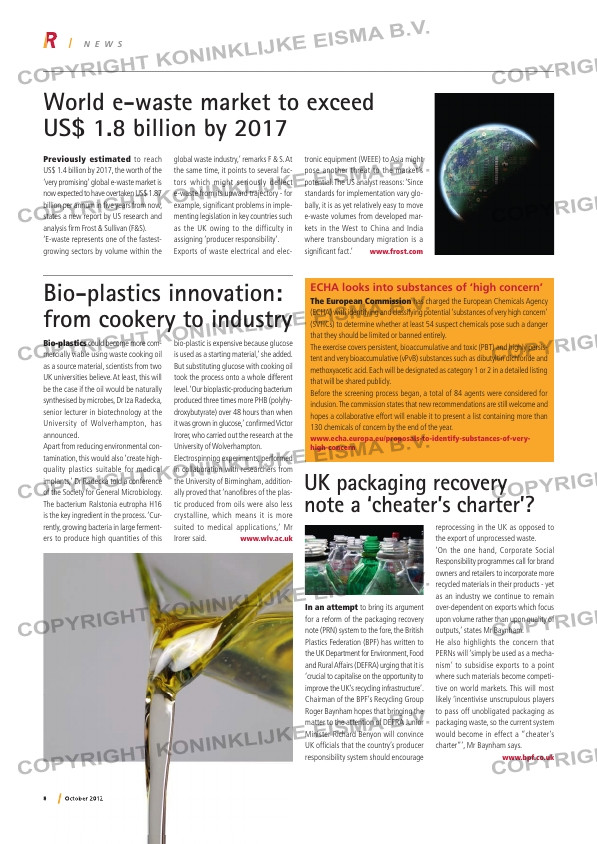Page 8 from: October 2012

8 October 2012
N E W S
World e-waste market to exceed
US$ 1.8 billion by 2017
Previously estimated to reach
US$ 1.4 billion by 2017, the worth of the
‘very promising’ global e-waste market is
now expected to have overtaken US$ 1.87
billion per annum in fi ve years from now,
states a new report by US research and
analysis fi rm Frost & Sullivan (F&S).
‘E-waste represents one of the fastest-
growing sectors by volume within the
global waste industry,’ remarks F & S. At
the same time, it points to several fac-
tors which might seriously deflect
e-waste from its upward trajectory – for
example, signifi cant problems in imple-
menting legislation in key countries such
as the UK owing to the difficulty in
assigning ‘producer responsibility’.
Exports of waste electrical and elec-
tronic equipment (WEEE) to Asia might
pose another threat to the market’s
potential. The US analyst reasons: ‘Since
standards for implementation vary glo-
bally, it is as yet relatively easy to move
e-waste volumes from developed mar-
kets in the West to China and India
where transboundary migration is a
signifi cant fact.’ www.frost.com
Bio-plastics innovation:
from cookery to industry
Bio-plastics could become more com-
mercially viable using waste cooking oil
as a source material, scientists from two
UK universities believe. At least, this will
be the case if the oil would be naturally
synthesised by microbes, Dr Iza Radecka,
senior lecturer in biotechnology at the
University of Wolverhampton, has
announced.
Apart from reducing environmental con-
tamination, this would also ‘create high-
quality plastics suitable for medical
implants,’ Dr Radecka told a conference
of the Society for General Microbiology.
The bacterium Ralstonia eutropha H16
is the key ingredient in the process. ‘Cur-
rently, growing bacteria in large ferment-
ers to produce high quantities of this
bio-plastic is expensive because glucose
is used as a starting material,’ she added.
But substituting glucose with cooking oil
took the process onto a whole different
level. ‘Our bioplastic-producing bacterium
produced three times more PHB (polyhy-
droxybutyrate) over 48 hours than when
it was grown in glucose,’ confi rmed Victor
Irorer, who carried out the research at the
University of Wolverhampton.
Electrospinning experiments, performed
in collaboration with researchers from
the University of Birmingham, addition-
ally proved that ‘nanofi bres of the plas-
tic produced from oils were also less
crystalline, which means it is more
suited to medical applications,’ Mr
Irorer said. www.wlv.ac.uk
UK packaging recovery
note a ‘cheater’s charter’?
In an attempt to bring its argument
for a reform of the packaging recovery
note (PRN) system to the fore, the British
Plastics Federation (BPF) has written to
the UK Department for Environment, Food
and Rural Affairs (DEFRA) urging that it is
‘crucial to capitalise on the opportunity to
improve the UK’s recycling infrastructure’.
Chairman of the BPF’s Recycling Group
Roger Baynham hopes that bringing the
matter to the attention of DEFRA Junior
Minister Richard Benyon will convince
UK offi cials that the country’s producer
responsibility system should encourage
reprocessing in the UK as opposed to
the export of unprocessed waste.
‘On the one hand, Corporate Social
Responsibility programmes call for brand
owners and retailers to incorporate more
recycled materials in their products – yet
as an industry we continue to remain
over-dependent on exports which focus
upon volume rather than upon quality of
outputs,’ states Mr Baynham.
He also highlights the concern that
PERNs will ‘simply be used as a mecha-
nism’ to subsidise exports to a point
where such materials become competi-
tive on world markets. This will most
likely ‘incentivise unscrupulous players
to pass off unobligated packaging as
packaging waste, so the current system
would become in effect a “cheater’s
charter”’, Mr Baynham says.
www.bpf.co.uk
ECHA looks into substances of ‘high concern’
The European Commission has charged the European Chemicals Agency
(ECHA) with identifying and classifying potential ‘substances of very high concern’
(SVHCs) to determine whether at least 54 suspect chemicals pose such a danger
that they should be limited or banned entirely.
The exercise covers persistent, bioaccumulative and toxic (PBT) and highly persis-
tent and very bioaccumulative (vPvB) substances such as dibutyltin dichloride and
methoxyacetic acid. Each will be designated as category 1 or 2 in a detailed listing
that will be shared publicly.
Before the screening process began, a total of 84 agents were considered for
inclusion. The commission states that new recommendations are still welcome and
hopes a collaborative effort will enable it to present a list containing more than
130 chemicals of concern by the end of the year.
www.echa.europa.eu/proposals-to-identify-substances-of-very-
high-concern
R _8- .indd 8 09-10-12 10:26



